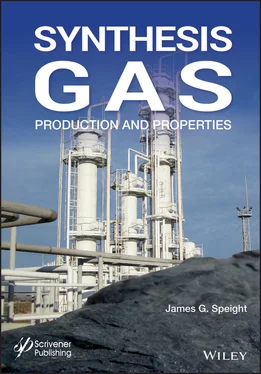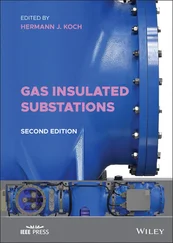Therefore, a brief comment about each of the potential energy sources is presented below.
1.2.1 Natural Gas and Natural Gas Hydrates
It is rare that crude oil and also heavy crude oil do not occur without an accompanying cover of gas (Speight, 2014a, 2019b). It is therefore important, when describing reserves of crude oil, to also acknowledge the occurrence, properties, and character of the natural gas. In recent years, natural gas has gained popularity among a variety of industrial sectors. Natural gas burns cleaner than coal or crude oil, thus providing environmental benefits. Natural gas is distributed mainly via pipeline, and some in a liquid phase (LNG) transported across oceans by tanker.
Assuming that the current level of natural gas consumption for the world is maintained, the reserve would be enough to last for another 64 years. However, in this estimation of natural gas longevity, factors such as the increase in annual consumption, the discovery of new reservoirs, and advances in discovery/recovery technology, and utilization of natural gas hydrates are not included. As a result of discoveries of gas in tight shale formations – which has offset more than the annual consumption – the world reserves of natural gas have been in a generally upward trend, due to discoveries of major natural gas fields.
Natural gas liquids (NGLs) – which are the higher-boiling constituents of natural gas separated from natural gas at a gas processing plant, and include ethane, propane, butane, and pentanes – have taken on a new prominence as shale gas production has increased and prices have fallen (Ratner and Tiemann, 2014). As a result, most producers are accepting the challenges with the opportunism and have shifted production to tight formations, such as the Bakken formation in North Dakota and Montana, to capitalize on the occurrence of natural gas liquids in shale gas development (Speight, 2013f; Sandrea, 2014; Speight, 2015a).
Methane hydrates (also often referred to as methane clathrates) is a resource in which a large amount of methane is trapped within a crystal structure of water, forming a solid similar to ice ( Chapter 1) (Collett, 2009). Methane hydrates exist as methane (the chief constituent of natural gas) trapped in a cage-like lattice of ice which, if either warmed or depressurized (with suitable caution), revert back to water and natural gas. When brought to the surface of the Earth, one cubic meter of gas hydrate releases 164 cubic meters of natural gas.
Gas hydrates occur in two discrete geological situations: (i) marine shelf sediments and (ii) on-shore Polar Regions beneath permafrost (Kvenvolden 1993; Kvenvolden and Lorenson, 2000). These two Hydrates occur in these two types of settings because these are the settings where the pressure-temperature conditions are within the hydrate stability field (Lerche and Bagirov, 1998). Gas hydrates can be detected seismically as well as by well logs (Goldberg and Saito, 1998; Hornbach et al. , 2003).
When drilling in crude oil-bearing and gas-bearing formations submerged in deep water, the reservoir gas may flow into the well bore and form gas hydrates owing to the low temperatures and high pressures found during deep water drilling. The gas hydrates may then flow upward with drilling mud or other discharged fluids. When the hydrates rise, the pressure in the annulus decreases and the hydrates dissociate into gas and water. The rapid gas expansion ejects fluid from the well, reducing the pressure further, which leads to more hydrate dissociation and further fluid ejection.
1.2.2 The Crude Oil Family
Crude oil and the equivalent term petroleum , cover a wide assortment of materials consisting of mixtures of hydrocarbon derivatives and other compounds containing variable amounts of sulfur, nitrogen, and oxygen, which may vary widely in volatility, specific gravity, and viscosity. Metal-containing constituents, notably those compounds that contain vanadium and nickel, usually occur in the more viscous crude oils in amounts up to several thousand parts per million and can have serious consequences during processing of these feedstocks. Because crude oil is a mixture of widely varying constituents and proportions, its physical properties also vary widely and the color from colorless to black. The crude oil family consists of various types of crude oil: (i) conventional crude oil, (ii) crude oil from tight formations, (iii) opportunity crude oils, (iv) high acid crude oil, (v) foamy oil, (vi) eavy crude oil.
The total amount of crude oil is indeed finite, and, therefore, production will one day reach a peak and then begin to decline. This is common sense, as explained in the resource depletion theory which, in this case, assumes that reserves of crude oil will not be replenished (i.e., that abiogenic replenishment is negligible) and future world oil production must inevitably reach a peak and then decline as these reserves are exhausted (Hubbert, 1956, 1962). There is no doubt that crude oil and natural gas are being consumed at a steady rate but whether or not the Hubbert peak oil theory will affect the consumption of crude oil is another issue. It is a theory that is based on reserve estimates and reserve consumption. No one will disagree that hydrocarbon resources (in the form of crude oil and natural gas) are finite resources and will run out at some future point in time but the proponents of an energy precipice must recognize that this will not be the case, at least not for now (Speight and Islam, 2016). The issue is the timing of this event – whether it is tomorrow, next week, next month, next year, or in 50 or more years remains to be seen. Current evidence (Speight, 2011a, 2011c; BP, 2019) favors a lifetime of more than 50 years for the current reserves of crude oil and natural gas, perhaps longer if hydraulic fracturing continues to play a dominant role in crude oil and natural gas production (Speight, 2015a). Thus, controversy surrounds the theory – not so much from the theory itself which is quite realistic but from the way in which the theory is used by varying collections of alarmists – since predictions for the time of the global peak is dependent on the past production and discovery data used in the calculation.
To date, crude oil production on a worldwide basis has come almost exclusively from what are considered to be conventional crude oil reservoirs from which crude oil can be produced using tried-and-true recovery technologies compared with non-conventional sources that require more complex or more expensive technologies to extract – examples of such resources are tar sand bitumen, liquids from coal, liquids from biomass, and liquids from oil shale (Lee, 1990; Scouten, 1990; Lee, 1991; Speight, 2008, 2011b, 2012, 2013a, 2014b, 2016).
Generally, crude oil from tight formations (sometimes referred to as unconventional tight oil resources) are found at considerable depths in sedimentary rock formations that are characterized by very low permeability. While some of the tight oil plays produce oil directly from shales, tight oil resources are also produced from low-permeability siltstone formations, sandstone formations, and carbonate formations that occur in close association with a shale source rock.
Oil from tight shale formation is characterized by a low content of high-boiling (resid) constituents, low-sulfur content, and a significant molecular weight distribution of the paraffinic wax content (Speight, 2014a, 2015b). Finally, the properties of crude oils from tight formations are highly variable. Density and other properties can show wide variation, even within the same field. The Bakken crude is light and sweet with an API of 42° and a sulfur content of 0.19% w/w. Similarly, Eagle Ford is a light sweet feed, with a sulfur content of approximately 0.1% w/w and with published API gravity between 40° API and 62° API.
Читать дальше












